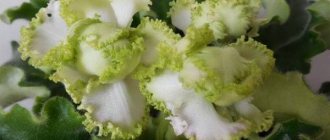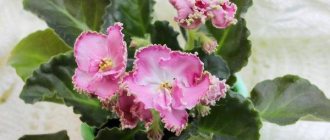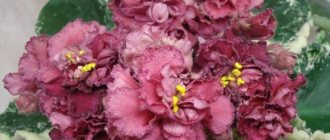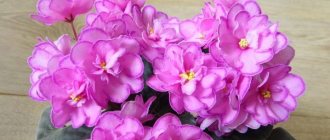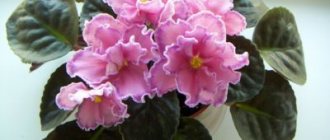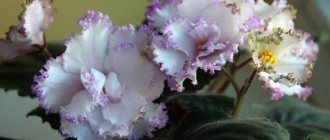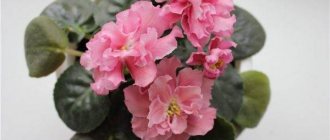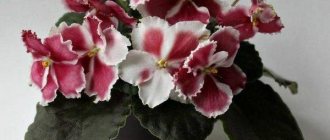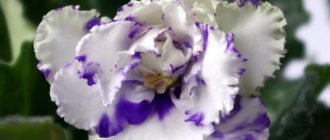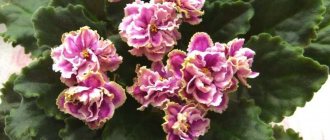Delicate, bright violets took pride of place on the windowsills and shelves of apartments. differ from their relatives growing in natural conditions :
- Long flowering;
- Bright and varied colors;
- And resistance to various environmental factors.
But the most unpretentious variety, with poor care, will not grow with a neat symmetrical rosette and will not produce beautiful cap blooms. Therefore, it is so important to know and follow the recommendations for caring for the Uzambara violet variety.
Description of the variety and photographs of violet Almond
Photos and descriptions of the Almond variety impress even those gardeners who have never grown violets in their apartment. Huge, up to 8-9 centimeters in diameter, pink-peach stars with a white eye in the center and a white border along the edge of the wavy petals are surrounded by dark green leaves. The flower petals are gracefully curved and retain their shape thanks to their dense texture.
The rosette of the variety is large, 30-40 centimeters, but compact, thanks to the leaves hugging the pot. The leaves of the variety are dark green, with a shiny surface, rounded in shape. There are faint serrations along the edges of the leaves.
[adsp-pro-4]
A maximum of 3 buds are formed at the same time in the center of the rosette; 1-2 of them are constantly in bloom. But due to their size, the bloomed flowers look like a whole bouquet. The peduncles of the variety are not thick, but strong, so they bend a little under the weight of the buds. But the flowers don't fall on the leaves. Each flower remains in bloom for about a month.
Features of flowering, growth and reproduction
Knowing how to properly root stepchildren and leaf cuttings, growing a daughter rosette will not be difficult . And with proper care, the violet rosette will:
- Produce new and new buds;
- And the huge flowers will delight you with their beauty for a month.
How long does it take to grow an adult plant?
From the moment the cuttings are planted until the tiny babies appear, 2 to 4 weeks pass . It will take a few more months to transplant into separate cups so that the children:
- Got stronger;
- And they gained sufficient leaf mass.
From the moment young violets separate from the mother leaf, another 5 to 7 months will pass .
Attention! Experienced flower growers recommend propagating Almond seedlings by stepsons.
How are varietal characteristics transmitted?
The violet often does not take stepson ; to obtain stepsons, the growth point at the rosette is pinched and nitrogen fertilizer is applied to stimulate growth.
Advice! Seedling by Konstantin Morev - Almonds are best propagated by separating stepchildren.
Another popular method is to root a leaf cutting from the mother rosette.
Features of flowering in hot and cool conditions
The variety is temperature dependent ; in warm conditions there is no white content on the petals at all.
In the warm season, Saintpaulia blooms without white spots.
What do flower stalks look like?
The peduncles of this violet variety are not thick , but strong. Under the weight of the buds they bend slightly, but the flowers hold.
Is it possible to achieve cap flowering?
Most often, about 3-4 buds are formed at the same time , so it cannot be called cap flowering. But, due to the huge size of the flowers, they look like a whole bouquet.
Bud lifespan
increase in size as they open . They remain in dissolution for about one month.
The unusually beautiful seedling of Konstantin Morev Almond, subject to the rules of cultivation and proper care, will delight its owner with huge salmon flowers at any time of the year.
Rules of maintenance and care
Like most large-flowered varieties, Almond violet is capricious. Therefore, growing a specimen that matches the description of the variety is quite difficult. The outlet needs to be provided with almost ideal conditions and increased attention.
The formation of large flowers of interesting color and a symmetrical, developed rosette can be achieved by ensuring the following conditions:
- Optimal temperature. Violet Almond is temperature dependent. In the heat, the color of the petals becomes monotonous, without whiteness in the center and along the edge. The flowers have a characteristic color for the variety at a temperature of 20-24 degrees. Critical temperatures for violets are below 13 and above 28 degrees.
- Sufficient lighting. Violet Almond is sensitive to light levels. The ideal place for growing it is an east window or a shelf illuminated by a fluorescent lamp. North-facing windows are not suitable for the plant. To properly form a rosette, turn the pot to the light source with the other side every 3-4 days.
- In order for the Almond violet to bloom in large flowers, you must follow all care recommendations.
Moderate watering. Waterlogged soil is the main enemy of this variety. Even a short stay in too wet soil negatively affects the well-being of the plant and causes rotting of the roots. Experienced gardeners recommend growing this variety using wick irrigation.
- Air humidity is not less than 50 and not more than 70%. You can increase the humidity level by placing the pot on a tray of expanded clay filled with water. In this case, the bottom of the pot should not touch the water. Excessive humidity is eliminated by regular ventilation.
- Maintaining leaf hygiene. Once a month, the violet is given “bath procedures.” The plant is placed in a bathtub and washed with a weak stream of warm water. The violet can be returned to the windowsill only after the leaves have completely dried.
Planting the Almond violet variety and caring for the plant
Violet Almond: photo
Like most other varieties, the Almond variety is a rather capricious violet. Therefore, in order to obtain a specimen that will correspond to the description and characteristics of the variety, it is worth putting a lot of effort and trying very hard. The rosette needs the grower to provide close to ideal conditions, create a favorable microclimate, and also always show increased attention to plantings in order to be able to determine in time what the plants need, whether there are any deviations from the norms for growing and breeding violets , and how to deal with them so that the planting does not die prematurely and does not lose its decorative characteristics.
In order for very large and bright plants to form on the Almond violet bush, several basic conditions must be observed: maintain the optimal air temperature in the room where the violet grows, give the flower the maximum lighting it needs; carry out moderate watering in accordance with the schedule and based on the planting condition; take into account the limits of air humidity in the room and maintain general hygiene of the flower. We’ll talk about these points further, but in more detail and detail, describing every nuance.
Let's start with the optimal air temperature - the Almond violet is very dependent on the temperature regime, since in many ways it is this characteristic that determines its comfort and well-being, growth rates, and flowering brightness. In hot weather, flowers become very monotonous in color, they do not mix at all in shades either in the center or at the edges, the flower looks a little boring, although the gardener can independently influence this factor. To achieve the most suitable color that will be characteristic of a given variety, the air temperature in the room should be from twenty to twenty-four degrees. There are also critical temperature intervals at which there is a high probability that the violet will simply die. This is when the temperature drops below thirteen degrees, or the thermometer approaches thirty degrees. So you should definitely ensure that the temperature is within the most favorable limits every year, otherwise this may lead to the fact that the plant will simply be lost.
Violet Almond: photo
The second indicator is lighting. Violet Almond is generally extremely sensitive to this aspect. Ideally, grow it on window sills with an eastern orientation, as well as on shelves that will be illuminated using phytolamps or fluorescent lighting. Windows that are directed to the north are generally not suitable for this plant, since there the flower will not receive enough lighting and, accordingly, it will be completely undecorative, unattractive and very faded. In addition, its root system may weaken there, which will lead to weakened immunity, a decrease in the level of stress resistance - the plant will begin to get sick. In order to properly form a rosette, it is recommended to turn the flower over from time to time so that it grows evenly. Typically, the container is turned over once every three to four days, turning parts of the violet towards the sun.
Waterlogged soil can become the real enemy of plantings, and especially for violets of this particular variety. Even if the root system has not been in too wet soil for very long, this will still not have the best effect on the plant. Also, an excess of moisture and waterlogging of the soil can lead to the fact that the root system begins to rot, which is why a variety of diseases and infections begin to progress. So you should be very careful about the watering procedure, and more experienced gardeners say that it is recommended to use the wick method for watering this particular variety. Also, for irrigation you should take warm, settled water; rain and melt water, filtered water are perfect. Under no circumstances should you use cold running water, as this may cause the plant to experience a very severe shock. Also, watering should be carried out in accordance with the schedule and as the top layer of soil begins to dry out. In this matter, it is also recommended to focus on the general condition of the plant, how it looks, how strong and healthy the leaves and buds are.
Air humidity should vary from fifty to seventy percent. You can manually adjust the air humidity and increase it if necessary. For example, place containers with wet expanded clay or pebbles near containers with violets. In this case, in no case should you place containers directly with flowers in wet trays, or you can do this, but in such a way that the bottom of the pot does not touch the moisture. Otherwise, because of this, the plant will take in too much moisture, which will lead to the plant beginning to suffer due to excess, and the root system will begin to rot. Too much humidity can be eliminated by regularly and moderately ventilating the areas where the plantings are located. Only through the actions of the gardener himself can life be made much better, and the plants will reciprocate - excellent flowering and decorative external characteristics.
Let's talk about how to maintain the cleanliness and hygiene of violet leaves of the SM-Almond variety. About once a month it is recommended to give violets water hygiene procedures. To do this, the plant is carefully placed in the bathroom, and then it must be washed with a stream of warm water. Under no circumstances should you use very cold or very hot water for this, as this can irritate the flower and it will simply get sick for a while. The violet is put back on the windowsill only after the leaves are completely dry; you can additionally blot them with a napkin to speed up this process.
Violet Almond: video
Features of feeding
Violet is extremely sensitive to the level of nutrients in the soil. The plant receives its main nutrition from the substrate, which is recommended to be changed annually. When transplanting into the soil, it is recommended to add simple mineral fertilizers as a source of basic substances: nitrogen, phosphorus and potassium. For violets, use Superphosphate - a teaspoon per liter of soil substrate.
[adsp-pro-5]
1.5-2 months after transplantation, root feeding begins with two types of liquid fertilizers:
- Organic is the main source of nitrogen. Organic fertilizers are applied to the soil at the stage of violet rosette formation, since nitrogen promotes the growth of green mass. At home, it is recommended to use Gumi, Raduga, and Ideal fertilizers. The use of microbiological fertilizer Baikal EM1 gives good results.
- Complex minerals - special mineral mixtures for violets or universal preparations in the form of powders or liquids. Mineral supplements contain phosphorus and potassium, which are necessary for the formation of buds and abundant flowering. For violets, it is recommended to use fertilizers Master, Fertika, Bona Forte, Uniflor.
For lush flowering, Almond violets must be fed.
Advice. Violet almond responds positively to monthly watering with a weak solution of potassium permanganate. It serves as a source of potassium and manganese, slightly increases the acidity of the soil and washes out excess salts from it.
Rules for transplanting violets Almonds
It is necessary to replant the almond violet twice a year, since the plant’s stem quickly becomes exposed and the rosette loses its decorative effect. When replanting, the violet stem must be buried to the level of the lower leaves, but in such a way that they do not touch the soil.
By the fourth year of life, the stem lengthens so much that it is necessary to rejuvenate the rosette. To do this, remove the bottom row of leaves and cut off the crown of the rosette, leaving a 3-4 centimeter long stem under the second row, and plant the violet in a loose substrate. The crown quickly takes root, and the rosette begins to actively grow new leaves.
To grow violets, use pots with a diameter of no more than 13 centimeters. Young rosettes are planted in containers from 6 to 9 centimeters. The size of the pot grows along with the increase in the root rosette.
Important. You cannot immediately plant young plants in large pots and expect them to grow. If there is room for the roots in the container, the violet will begin to grow roots and leaves, but will not bloom.
Young violets Almonds should not be planted in pots that are too spacious.
The substrate for planting violets should be as loose and light as possible. If you do not want or have the opportunity to purchase ready-made soil for violets, you can prepare the soil yourself. It is necessary to mix 5 parts of turf and leaf soil, 3 parts of peat, 1 part of sand. To loosen, add vermiculite or perlite to the mixture (10% of the volume of the mixture).
Main problems
As mentioned earlier, this variety of violet is very capricious, especially when it comes to optimal conditions. If they are violated, various diseases may develop, a lack of flowering, and even the death of the plant. Therefore, every novice gardener should know about special indicators that indicate a particular error in care:
- rapid growth of foliage - excess nitrogen or lack of light;
- pale green leaves with curling edges – low temperature;
- gray coating on green plates – increased air humidity;
- yellowed flowers - too dry soil or air;
- brown spots on the leaves are sunburn.
When the first signs of the disease appear, it is necessary to immediately make adjustments to the growing conditions. If the disease continues to progress, you should use any fungicidal drug intended for indoor plants. An ideal option would be “Fitosporin”. The drug not only allows you to quickly eliminate the problem, but also significantly improves the decorative qualities of the plant, strengthening its immune system.
Problems and mistakes when growing plants
Violet Almond is quite capricious. If the rules for its cultivation and care are not followed, there is a risk of plant death or lack of flowering.
[adsp-pro-6]
The following signs indicate problems:
- Brown spots on the leaves are the result of watering with cold water or sunburn.
- Yellowing of leaves - overexposure, too dry and humid air.
- Gray plaque on the leaves is gray rot. Temperature too low with high humidity.
- Pale green leaves with edges curving downwards mean the temperature is too low, most often at night.
- Rapid growth of foliage and shoots in the absence of flowering - lack of light, excess nitrogen, too spacious pot. This phenomenon can occur when stepsons are not removed in a timely manner.
- Plaque and spots on the leaves indicate the development of violet disease.
Limp leaves with sufficient moisture in the soil are fusarium.
- White coating on leaves and peduncles is powdery mildew. The cause of infection by this fungus is low temperature and high humidity.
- Brown or red spots on the leaves and lumps of fluff in the axils are scales.
- Sticky coating on the surface of the leaves and brown dots on the bottom are aphids.
- Deformed leaves with depressed red or yellow spots, a compacted center of the rosette - mites.
When the first signs of disease development appear, the violet must be sprayed with an insecticide or fungicide. First, you need to remove all damaged parts from the violet and replant it in a new pot with a complete replacement of the soil. Urgent measures must be taken immediately when the first signs appear, otherwise the plant cannot be saved.
Possible diseases to which violet Almond is susceptible
The Almond violet variety is quite capricious, and it is not surprising that sometimes even experienced gardeners can make some mistakes when it comes to planting and caring for this crop indoors. If you do not follow the rules of cultivation and agricultural technology, this can lead to the fact that the growth of the violet will slow down, there will be no flowering, and as a result the plant will simply die. The plant itself literally immediately reports that there are some problems, and the gardener needs to resolve them as soon as possible so as not to lose his own attractive planting. Typically, these are the following signs of violet malaise:
- the appearance of spots colored brown is a sign that the gardener watered with cold water, which causes an exceptional shock to the planting. Brown spots may also be caused by a burn resulting from placing the violet in direct sunlight.
- yellowing of the leaves indicates an excess of lighting, too dry air or that the air is too humidified, and this immediately affects the condition of the plant
- gray plaque on the leaves is a sign of the formation of a very dangerous disease - gray rot. It is caused by low temperatures provided that air humidity is above normal
- if the leaves turn very pale, and the edges begin to bend downward, the leaf begins to deform, then this indicates that the plant is kept at too low temperatures, and most often these low temperatures catch planting at night, which is why the plant feels so uncomfortable
- The deciduous part may suddenly begin to grow very rapidly, while there will be no flowering - this happens when the violet does not have enough sunlight or lighting in general. Foliage also begins to grow due to an excess of nitrogen-containing components, as well as due to the fact that the pot was chosen to be very large, and therefore the plant cannot evenly distribute its forces and generally understand how to continue to grow so that there is both flowering and strong root system, and attractive foliage. Also, the foliage grows due to the fact that the grower does not remove the stepsons in time, and it is recommended to do this regularly with the onset of the appropriate period.
The leaves of the Almond violet can become very limp, which indicates that there is enough moisture, but the plant has already been affected by one of the most dangerous diseases - fusarium. A whitish coating may form on the peduncles and leaves, which becomes the first symptom of the development of powdery mildew. The fungus affects the plant mainly due to the fact that the planting is kept at too low air temperatures, and at the same time the air humidity in the room is higher than normal. Red or brown spots may appear on the leaves, and small lumps of fluff form in the axils, which becomes a clear sign that the plant has been attacked by scale insects. Aphids appear as a small, very light coating on the surface of the leaves, and brown dots appear on the lower part of the leaves. This suggests that the aphids began to gradually pierce the leaves and suck out the juice and all the nutrients from them. If the leaves gradually become deformed, change shape, and slightly depressed red or yellow spots form on them, then this is precisely a sign of pests such as mites.
If a florist notices one or more of the signs that we have listed on Almond Moreva violets, then it is necessary to immediately spray the violet with preparations from the insecticidal and fungicidal group. All parts of the plant that have become damaged must be removed from the violet and the flower transplanted into a new container, which is first filled with fresh soil. Urgent measures must be taken immediately after the grower sees that some unpleasant events are happening to the plant, otherwise this may lead to the disease gradually progressing, the pests will multiply even more actively and spread throughout the plantings, and As a result, the plant will simply die. This entirely depends on the measures and capabilities of the grower himself, since this is really very important not only to save the planting, but also to make the plant stronger, flowering more abundantly and brighter.
Reproduction methods
Violet almond is a bit difficult to reproduce. Stepchildren rarely give rosettes on their own. To get daughter rosettes, you need to pinch the growth point of the main rosette and at the same time add nitrogen fertilizer to the soil. This technique stimulates the formation of daughter shoots - stepchildren - in the axils of the lower leaves.
As soon as 2-3 leaves with cuttings of at least 3-4 centimeters grow on the resulting stepsons, they are separated from the mother plant and planted for rooting in a mixture of sand, peat and vermiculite. The top of the stepson is covered with a transparent cap. Experienced gardeners also advise rooting stepsons in damp sphagnum moss placed in plastic containers with a lid.
Important. In order not to damage the stepson's growth point, it is separated from the mother's rosette using an awl, scalpel or toothpick. You need to cut off the stepson at the point where it is attached to the leaves of the mother's rosette.
Violet Almonds are best propagated by separating the stepsons.
An alternative way to propagate violets is by rooting leaf cuttings. A healthy, well-developed leaf from the second row of the rosette is cut obliquely with a sharp knife or blade and placed in a glass of water. After the formation of roots 1-1.5 centimeters long on the cuttings, it is planted in a cup filled with loose substrate.
Babies on cuttings with pre-grown roots are formed in 4-5 weeks. You can separate them from the cuttings and plant them in pots only after the diameter of the leaves reaches 3-4 centimeters.
Reviews from flower growers about violet Almond
Lyra. Violet is too capricious and needs a lot of attention. Something just goes wrong, the leaves begin to curl. But such a huge flower is worth it. The violet is difficult to reproduce and reluctantly produces children when the leaves take root.
See the description of the Black Pearl violet and read reviews about the variety.
Violet First date: description of the variety in the full article.
Natalie . When I first came across a description of the violet variety Almond, I didn’t believe that there could be such large flowers. But I decided to check it out, and a miracle happened. The starter produced a flower of 6.5 centimeters. The second flowering pleased me with a flower of about 8 centimeters. I’m waiting for the third flowering, but already now I’m one hundred percent satisfied with the variety. The flower has an original shape, pink-salmon color, white edges of the petals. Beauty!
Reviews
Yana. “Having seen the description of the Almond violet variety, I couldn’t believe for a long time that my baby would have the same huge flowers. And now, the long-awaited flowering, the flowers are simply gigantic, with a diameter like a violet pot. I am delighted!"
Larisa. “I bought a starter at an exhibition, and a month later the first flowers bloomed. They are so large, almost 7 cm. And already the second flowering caused a sensation, not only for me, but also for all my friends. Now they unanimously ask for such a baby.”
Saintpaulia is grown by many gardeners.
Stanislava. “Favorite variety! I have never seen such huge flowers anywhere before. The rosette sometimes hugs the pot, but this does not spoil the impression of the variety. It’s on wick watering, no problems with it.”

